Steven Soderbergh facts for kids
Quick facts for kids
Steven Soderbergh
|
|
|---|---|
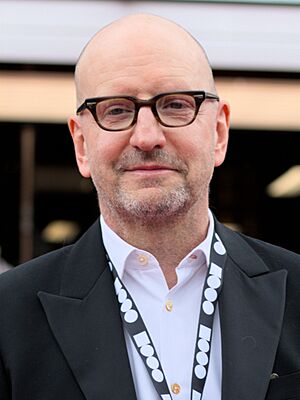
Soderbergh in 2024
|
|
| Born |
Steven Andrew Soderbergh
January 14, 1963 Atlanta, Georgia, U.S.
|
| Other names | Sam Lowry Peter Andrews Mary Ann Bernard |
| Occupation |
|
| Years active | 1981–present |
|
Works
|
Filmography |
| Movement | Independent cinema |
| Spouse(s) |
Betsy Brantley
(m. 1989; div. 1994)Jules Asner
(m. 2003) |
| Children | 2 |
Steven Andrew Soderbergh (born January 14, 1963) is an American film director, producer, screenwriter, cinematographer, and editor. He is known for being a leader in modern independent cinema. Later, he also made popular films within the big studio system.
Soderbergh's first big success was the independent drama ... , Lies, and Videotape (1989). This movie made him famous in the film world. At 26, Soderbergh became the youngest director to win the top award, the Palme d'Or, at the Cannes Film Festival. The film was a big hit around the world and won many awards. His next few films, like King of the Hill (1993), were liked by critics but did not make much money. He then started making more mainstream movies, such as the crime comedy Out of Sight (1998), the true story Erin Brockovich (2000), and the crime drama Traffic (2000). For Traffic, he won the Academy Award for Best Director.
Soderbergh continued to have success with the Ocean's trilogy (2001–2007), Che (2008), The Informant! (2009), Contagion (2011), Haywire (2011), the Magic Mike trilogy (2012–2023), Side Effects (2013), Behind the Candelabra (2013), Logan Lucky (2017), Unsane (2018), Let Them All Talk (2020), No Sudden Move (2021), Kimi (2022), Presence (2024), and Black Bag (2025). His movies cover many different types of stories, but he often focuses on psychological, crime, and heist films. His films have earned over $2.2 billion worldwide and received fourteen Academy Award nominations, winning five.
Soderbergh's films often use ideas common in big Hollywood movies, but he usually adds an avant-garde arthouse touch. His movies explore themes like changing personal identities, revenge, and what it means to be human. His films often look unique because he is influenced by experimental cinema and uses different film and camera formats. Many of Soderbergh's films have complex stories with plot twists, non-linear storytelling, and exciting soundscapes.
Contents
Early Life and First Steps in Film
Steven Soderbergh was born on January 14, 1963, in Atlanta, Georgia. His mother was Mary Ann and his father was Peter Andrew Soderbergh, who worked as a university administrator. Steven has family roots from Sweden, Ireland, and Italy. His grandfather came to the U.S. from Stockholm, Sweden.
As a child, his family moved to Charlottesville, Virginia, and then to Baton Rouge, Louisiana. In Baton Rouge, his father became the Dean of Education at Louisiana State University (LSU). Steven became interested in filmmaking when he was a teenager. He made short films using Super 8 and 16 mm cameras. After high school, he moved to Hollywood to become a professional filmmaker.
His first job was keeping score for a game show and holding cue cards. Soon after, he started working as a freelance film editor. During this time, he directed a concert video called 9012Live for the rock band Yes in 1985. For this video, he was nominated for a Grammy Award for Best Music Video, Long Form.
Career Highlights
Starting His Directing Journey
After returning to Baton Rouge, Soderbergh wrote the script for ... , Lies, and Videotape in just eight days during a cross-country drive. The film tells the story of a man who records women talking about their lives, and how this affects a married couple. Soderbergh sent ... , Lies, and Videotape to the 1989 Cannes Film Festival. At 26, he became the youngest solo director to win the Palme d'Or, the festival's highest award. The film was a big hit, earning $36.7 million on a small budget of $1.2 million.
... , Lies, and Videotape is seen as a very important film for the Independent Cinema movement of the 1990s. Film critic Roger Ebert called Soderbergh the "poster boy of the Sundance generation." Because he was so young and became famous so quickly, people called him a "sensation" and a "prodigy." In 2006, ... , Lies, and Videotape was chosen by the Library of Congress to be kept in the United States National Film Registry. This means it was considered "culturally, historically, or aesthetically significant."
Challenges and Comeback Films
After his first big hit, Soderbergh made several low-budget films that did not do well at the box office. In 1991, he directed Kafka, a film about writer Franz Kafka. This movie earned only a small part of its budget. Two years later, he directed the drama King of the Hill (1993). This film also did not make much money but was liked by critics. It was based on a true story set during the Great Depression and followed a young boy trying to survive alone. In 1995, he directed The Underneath, which also struggled at the box office and received negative reviews. Soderbergh later said making this film felt like hitting rock bottom.
In 1996, Soderbergh directed Schizopolis, a comedy where he also starred, wrote, composed music, and filmed. The movie was confusing on purpose, with Soderbergh even saying in the introduction, "In the event that you find certain sequences or events confusing, please bear in mind this is your fault, not ours." He later called Schizopolis his "artistic wake-up call."
Rise to Mainstream Success
Soderbergh's career took a turn in 1998 with Out of Sight. This stylish film, based on a novel by Elmore Leonard, starred George Clooney and Jennifer Lopez. It was highly praised by critics and led to many more collaborations between Clooney and Soderbergh. He then made another crime film, The Limey (1999). In 2000, he directed Erin Brockovich, a true story starring Julia Roberts, who won an Oscar for her role. Later in 2000, Soderbergh released Traffic, a drama with many actors. Both Erin Brockovich and Traffic were nominated for awards at the 2001 Academy Awards. This made him the first director since 1938 to be nominated for Best Director for two different films in the same year. He won the Academy Award for Best Director for Traffic.
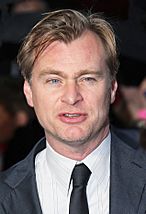
In 2001, Soderbergh directed Ocean's Eleven, a new version of a 1960s movie. The film was a huge success, becoming Soderbergh's highest-grossing movie at the time, earning over $450 million worldwide. Rolling Stone magazine said the movie "spawned a new era of heist movies." He also made Full Frontal that year, which was shot mostly on digital video. A year later, he was asked to direct the thriller Insomnia (2002), but he suggested that Christopher Nolan, a rising director, should direct it instead.
Before making more Ocean's movies, Soderbergh co-produced a political TV series called K Street (2003) with George Clooney. In 2004, Soderbergh directed Ocean's Twelve, the sequel to Ocean's Eleven. It was another commercial success. In 2005, Soderbergh directed Bubble, a low-budget film with non-professional actors. This film was released in theaters, on TV, and on DVD at the same time, which was unusual and caused discussion in the film industry.
In 2007, Soderbergh directed Ocean's Thirteen, which was also very successful and well-liked by critics. This film completed the Ocean's trilogy. In 2008, Soderbergh directed Che, a four-hour movie about the revolutionary Ernesto "Che" Guevara.
Mainstream Success and a Short Break
Soderbergh's 2009 film was The Informant!, a comedy starring Matt Damon as a corporate whistleblower. The film earned $41 million and received good reviews. In 2010, Soderbergh filmed the action-thriller Haywire, which was released in 2012.
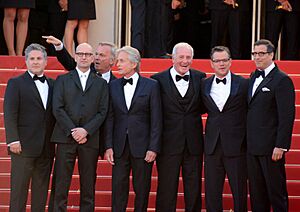
Also in 2010, Soderbergh filmed the virus thriller Contagion. This movie, with a big cast including Damon and Kate Winslet, showed a deadly global pandemic. It premiered in 2011 and was a commercial and critical success, earning $135.5 million. In 2011, Soderbergh also helped direct scenes for The Hunger Games. In late 2011, he filmed Magic Mike, a movie starring Channing Tatum about his experiences as a male dancer. The film was released in 2012 and was very popular.
Around this time, Soderbergh talked about taking a break from making feature films. He said he wanted to explore painting. For his film before his break, he directed the psychological thriller Side Effects, released in 2013. He also directed Behind the Candelabra (2013), a film for HBO about the famous pianist Liberace, starring Michael Douglas and Matt Damon.
In 2013, Soderbergh announced he would direct a ten-part miniseries for Cinemax called The Knick. The series followed doctors in a hospital in early 20th-century New York. It aired in 2014 and was highly praised. After two seasons, Soderbergh decided to step back from directing the show.
After The Knick, Soderbergh worked on other projects. In 2014, he directed an Off-Broadway play called The Library. He also released his own versions of classic films online, like a black-and-white silent version of Raiders of the Lost Ark to study filmmaking techniques. In 2015, it was announced Soderbergh would direct Mosaic, a series for HBO. It was released as an interactive movie app in 2017 and a miniseries in 2018.
Returning to Feature Films
In February 2016, Soderbergh officially returned to directing feature films with Logan Lucky, a NASCAR heist film starring Channing Tatum, Adam Driver, and Daniel Craig. The film was produced independently by Soderbergh and released in 2017 to great reviews.
In 2017, it was revealed that Soderbergh had secretly filmed a horror movie called Unsane using iPhones. The film, starring Claire Foy, was released in 2018 and was praised by critics. Using an iPhone to film was seen as inspiring for new filmmakers.
In 2018, Soderbergh directed High Flying Bird, released by Netflix in 2019. His 2019 film The Laundromat is a thriller about the international leak of the Panama Papers. It stars Meryl Streep and Gary Oldman and premiered at the Venice Film Festival before going to Netflix. Soderbergh's 2020 film Let Them All Talk, also starring Meryl Streep, was filmed on a cruise ship and released on HBO Max.
No Sudden Move (2021) is a crime film set in the 1950s, starring Don Cheadle and Benicio del Toro. It premiered at the Tribeca Film Festival and was released on HBO Max. Kimi (2022), starring Zoë Kravitz, was also released on HBO Max. Magic Mike's Last Dance (2023), the third film in the Magic Mike series, brought back Channing Tatum and introduced Salma Hayek. It was released in theaters.
Full Circle (2023) is a six-part miniseries released on Max. In July 2023, Soderbergh also launched his science fiction web series Command Z. His film, Presence, a haunted house thriller, premiered at the 2024 Sundance Film Festival. Soderbergh filmed the 2025 spy thriller Black Bag in London. He also produced an Off-Broadway play called The Fears. He filmed his next movie, The Christophers, a dark comedy, in London in early 2025. In April 2025, it was announced he was working on a documentary about John Lennon and Yoko Ono.
Filmmaking Style and Approach
How He Makes Films
Soderbergh's visual style often shows rich city settings, uses natural light, and features fast-paced environments. Film critic Drew Morton has compared his style to the French New Wave movement in filmmaking. Soderbergh likes to experiment and often avoids typical Hollywood film rules. He believes filmmakers are always at the beginning of something new, with endless possibilities.
Technically, Soderbergh often uses long close-ups, tracking shots, and jump cuts. He sometimes skips establishing shots, using sounds and other visuals instead. Many of his films create suspense using third-person views and many over-the-shoulder shots. In his film Contagion (2011), he used a "hyperlink cinema" style, where multiple stories connect, similar to his Ocean's trilogy. He is known for using different colored washes in his films, like yellow for open, normal situations and blue for illegal or secret activities. He also uses montages often, believing they are as important for storytelling as dialogue.
Soderbergh is known for having a challenging relationship with Hollywood and its studio rules. Film critic Roger Ebert once said that Soderbergh sometimes makes films that are hard to understand, almost like an amateur, perhaps as a way to stay humble.
In Ocean's Twelve (2004), he had actress Julia Roberts play a character who then had to pretend to be a fictional version of Julia Roberts. In Haywire (2011), Soderbergh cast and helped start the film career of professional mixed martial arts (MMA) fighter Gina Carano. Soderbergh's Logan Lucky (2017) even mentioned his Ocean's trilogy, showing its influence on other heist films.
Soderbergh's films often have exciting and atmospheric soundscapes. He creates suspense by introducing sounds before visuals in scenes, letting the viewer know something is about to change. He often works with composers Cliff Martinez, David Holmes, and Thomas Newman, who create the music and sounds for his films.
How He Works
Soderbergh's early films were shot on Super 8 and 16 mm film because he was young and had limited money. He has used many different types of cameras for his films. He filmed all of The Girlfriend Experience (2009) with a Red One camera, which was quite affordable for a movie. Soderbergh filmed all of Unsane (2018) using an iPhone 7 Plus with its 4K digital camera and a special app. He used three iPhones that rotated, held by a stabilizer. In 2018, he said he was interested in filming more movies only with iPhones. He then filmed High Flying Bird (2019) entirely on an iPhone 8.
Besides directing, he often writes the scripts for his films. Scott Tobias of The A. V. Club described his experimental filmmaking as "rigorously conceived, like a mathematician working out a byzantine equation." Since his 2000 film Traffic, Soderbergh has used different fake names, like Peter Andrews (his father's name) for cinematography and Mary Ann Bernard (his mother's name) for editing, to hide that he does so many jobs on his films.
When working with actors, Soderbergh prefers to let them do their work without too much interference. He says, "I try and make sure they're OK, and when they're in the zone, I leave them alone. I don't get in their way." This approach has led many famous actors to work with him repeatedly.
Common Themes in His Films
Soderbergh's films often explore themes of changing personal identities and the human condition. Richard Brody of The New Yorker noted that Soderbergh focuses on the way ideas are shown in film rather than just the ideas themselves. He often uses themes to look closely at political and corporate systems, like money and capitalism. Film critic A. O. Scott has pointed out Soderbergh's interest in how capitalist economies affect living an ethical life and the problems linked to materialism. Money is a key theme in many of his movies, as Soderbergh believes it is an obsession unlike any other.
Starting with Out of Sight (1998), Soderbergh's heist films explore themes of revenge, characters on a mission, and the right and wrong of crime. He is known for his skill in these types of films. He once said, "I've always had an attraction to caper movies, and certainly there are analogies to making a film. You have to put the right crew together, and if you lose, you go to movie jail."
Who Influenced Him
When asked about his favorite films, Soderbergh listed eleven movies he considered among the best. These included The 5,000 Fingers of Dr. T. (1953), All The President's Men (1976), Annie Hall (1977), Citizen Kane (1941), The Conversation (1974), The Godfather (1972), The Godfather Part II (1974), Jaws (1975), The Last Picture Show (1971), Sunset Boulevard (1950), and The Third Man (1949). His first film, ... , Lies, and Videotape (1989), was influenced by Mike Nichols' 1971 film Carnal Knowledge. He also said that Peter Yates' 1972 crime-comedy The Hot Rock inspired the feel of the Ocean's films. Soderbergh mentioned that Costa-Gavras's film, Z, was an inspiration for his film Traffic. He also looks to the Swiss-French director Jean-Luc Godard as "a constant source of inspiration."
Other Ventures
In 2018, Soderbergh started his own brand of a Bolivian grape spirit called "Singani 63." In 2014, he partnered with a distillery in Bolivia and became the only person to export this spirit from the mountains of Bolivia. Singani is a traditional Bolivian drink. Soderbergh prefers not to call singani a brandy, saying that "Millennials hate brandy." To show this, he made a short video comparing brandy and Singani 63.
Working with Others
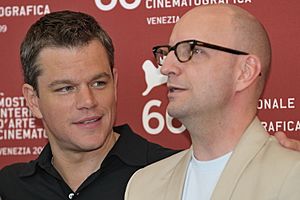
Soderbergh has worked with many actors, composers, and screenwriters throughout his career. His most frequent collaborators include George Clooney (who started a production company with him and has been in six of his films), Matt Damon (his most frequent collaborator, appearing in nine films), Brad Pitt, Julia Roberts, Don Cheadle, and Channing Tatum. Other actors who have appeared in many of his films are Luis Guzmán, Jude Law, Ann Dowd, Joe Chrest, Benicio Del Toro, Elliott Gould, Catherine Zeta-Jones, Michael Fassbender, Michael Douglas, and Albert Finney.
Among those who have won awards for working with Soderbergh, Julia Roberts won an Academy Award for Best Actress for Erin Brockovich. Benicio del Toro also won an Academy Award for his work in Traffic and later starred as Che Guevara in Che. Catherine Zeta-Jones was nominated for a Golden Globe for her role in Traffic and worked with him again on Ocean's Twelve and Side Effects.
Soderbergh often relies on Jerry Weintraub to produce many of his films. Composer Cliff Martinez has scored eleven of Soderbergh's films, from ... , Lies, and Videotape (1989) to Kimi (2022). Northern Irish composer David Holmes started working with him in 1998 on Out of Sight and scored the Ocean's trilogy. Composer Thomas Newman has worked on four of Soderbergh's films, most recently Let Them All Talk in 2020. Soderbergh often edits his own films, but he also works with editor Stephen Mirrione and frequently collaborates with screenwriters Scott Z. Burns, Lem Dobbs, David Koepp, and Ed Solomon.
His Thoughts on the Film Industry
Soderbergh strongly believes in protecting artistic quality in Hollywood, even against big corporations. He feels that "cinema is under attack by the studios and, from what I can tell, with the full support of the audience." He has said that he no longer reads reviews of his movies, stopping completely after Traffic.
Soderbergh does not like it when a director's name is put in front of a film's title, like "A Steven Soderbergh Film." He prefers not to have his name front and center. He says, "The fact that I'm not an identifiable brand is very freeing, because people get tired of brands and they switch brands. I've never had a desire to be out in front of anything." He often uses the fake name Peter Andrews for his cinematography work and Mary Ann Bernard for his editing work.
Personal Life
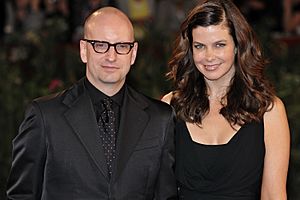
Soderbergh married actress Betsy Brantley in 1989. They had a daughter before divorcing in 1994. He has been married to Jules Asner since 2003. He often says she influences his female characters. He also has another daughter, born in 2010, with a woman in Australia. Soderbergh lives in New York City. His 2023 web series Command Z was filmed inside his own home.
Filmography
| Year | Film | Distributor |
|---|---|---|
| 1989 | ... , Lies, and Videotape | Miramax Films |
| 1991 | Kafka | |
| 1993 | King of the Hill | Gramercy Pictures |
| 1995 | The Underneath | |
| 1996 | Schizopolis | Northern Arts |
| Gray's Anatomy | IFC Films | |
| 1998 | Out of Sight | Universal Pictures |
| 1999 | The Limey | Artisan Entertainment |
| 2000 | Erin Brockovich | Universal Pictures / Columbia Pictures |
| Traffic | USA Films / Initial Entertainment Group | |
| 2001 | Ocean's Eleven | Warner Bros. Pictures |
| 2002 | Full Frontal | Miramax Films |
| Solaris | 20th Century Fox | |
| 2004 | Ocean's Twelve | Warner Bros. Pictures |
| 2005 | Bubble | Magnolia Pictures |
| 2006 | The Good German | Warner Bros. Pictures |
| 2007 | Ocean's Thirteen | |
| 2008 | Che: Part One Che: Part Two |
IFC Films / Wild Bunch |
| 2009 | The Informant! | Warner Bros. Pictures |
| 2011 | Contagion | |
| Haywire | Relativity Media | |
| 2012 | Magic Mike | Warner Bros. Pictures / FilmNation Entertainment |
| 2013 | Side Effects | Open Road Films / FilmNation Entertainment |
| Behind the Candelabra | HBO Films | |
| 2017 | Logan Lucky | Fingerprint Releasing / Bleecker Street |
| 2018 | Unsane | Fingerprint Releasing / Bleecker Street / 20th Century Fox |
| 2019 | High Flying Bird | Netflix |
| The Laundromat | ||
| 2020 | Let Them All Talk | Warner Bros. Pictures / HBO Max |
| 2021 | No Sudden Move | |
| 2022 | Kimi | |
| 2023 | Magic Mike's Last Dance | Warner Bros. Pictures |
| 2024 | Presence | Neon |
| 2025 | Black Bag | Focus Features / Universal Pictures |
| The Christophers | TBA |
Awards and Recognition
Soderbergh's films are often discussed and studied by fans, critics, and other directors. His early work, especially his 1989 film, ... , Lies, and Videotape, is considered very important for the start of the independent film movement. After directing his first film, Soderbergh's young age and quick rise to fame made him known as a "sensation" and a "prodigy" in the genre. In 2002, he was elected first Vice President of the Directors Guild of America.
After showing ... , Lies, and Videotape at the 1989 Cannes Film Festival, Soderbergh received the festival's top award, the Palme d'Or. At 26, he was the youngest solo director to win this award. For his script, Soderbergh was nominated for an Academy Award for Best Original Screenplay at the 62nd Academy Awards.
Soderbergh was nominated twice for Best Director for two different films at the 73rd Academy Awards. This was the first time this had happened since 1938. He won the award for Traffic, and was also nominated for Erin Brockovich. When the same thing happened at the Directors Guild of America Awards, the Associated Press called it a "Soderbergh vs. Soderbergh" contest.
For his work on Erin Brockovich and Traffic, Soderbergh became one of only five directors to win "The Big Four" critics awards (LAFCA, NBR, NYFCC, NSFC).
| Year | Feature Film | Academy Awards | BAFTA Awards | Golden Globe Awards | |||
|---|---|---|---|---|---|---|---|
| Nominations | Wins | Nominations | Wins | Nominations | Wins | ||
| 1989 | ... , Lies, and Videotape | 1 | 2 | 3 | |||
| 1998 | Out of Sight | 2 | |||||
| 2000 | Erin Brockovich | 5 | 1 | 6 | 1 | 4 | 1 |
| Traffic | 5 | 4 | 4 | 2 | 5 | 2 | |
| 2006 | The Good German | 1 | |||||
| 2013 | Behind the Candelabra | 5 | 4 | 2 | |||
| Total | 14 | 5 | 17 | 3 | 16 | 5 | |
See also
 In Spanish: Steven Soderbergh para niños
In Spanish: Steven Soderbergh para niños
- Steven Soderbergh's unrealized projects


